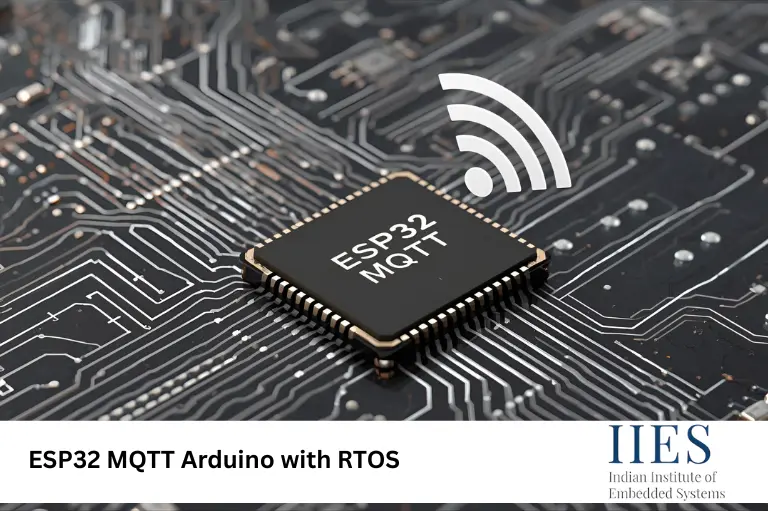
In the world of the Internet of Things (IoT), ESP32 MQTT Arduino implementations enable robust and scalable IoT applications. Leveraging the ESP32’s dual-core microcontroller, built-in Wi-Fi, and Bluetooth, combined with the MQTT protocol and RTOS such as FreeRTOS, developers can achieve real-time, reliable messaging for various IoT projects. Understanding ESP32 MQTT with RTOS is essential for building efficient and high-performance IoT systems.
ESP32 MQTT Arduino empowers IoT developers to create responsive, real-time systems. From ESP32 MQTT temperature sensors to ESP32 MQTT broker examples and AWS IoT integrations, mastering these fundamentals ensures scalable, high-performance applications ensures reliable and optimized designs.
The ESP32 is widely adopted in IoT projects due to its dual-core processing, Wi-Fi, and Bluetooth capabilities. By running an RTOS, tasks like sensor data collection, network communication, and command processing can run in parallel without blocking each other.
Adding MQTT to ESP32 enables seamless device connection using a publish/subscribe model. Together, they form the backbone of real-time IoT systems such as smart agriculture, industrial monitoring, and home automation.
# Clone the ESP-IDF framework git clone --recursive https://github.com/espressif/esp-idf.git # Export environment variables ../export.sh # Create a new ESP32 project idf.py create-project mqtt_rtos cd mqtt_rtos
MQTT provides efficient, lightweight communication across unstable or lossy networks. FreeRTOS helps manage multiple tasks simultaneously, preventing delays in data collection and transmission. When combined, they enable low-latency, modular, and scalable IoT communication.
For example, with ESP32 MQTT Arduino, you can read sensor data, send it to an MQTT broker (like ESP32 MQTT Mosquitto or AWS IoT), and still handle user commands—all at the same time.
You can use either:
# Install dependencies (esp-mqtt library) # In esp-idf, add espressif/esp-mqtt # Install ESP-IDF or Arduino core for ESP32 # Configure Wi-Fi SSID and password # Set up the MQTT broker URL (public broker, Mosquitto, or AWS IoT) # Adjust FreeRTOS task settings (stack size, priority)
The recommended library is esp-mqtt, which:
For an ESP32 MQTT broker example, you can start with test.mosquitto.org, then later move to cloud solutions like AWS IoT for production.
To keep the code modular and efficient, split responsibilities into multiple tasks:
// FreeRTOS task creation example xTaskCreate(&mqtt_task, "mqtt_task", 4096, NULL, 5, NULL); // Create a queue for sensor data xQueueHandle sensor_data_queue = xQueueCreate(10, sizeof(sensor_data_t));
esp_mqtt_client_config_t mqtt_cfg = {
.uri = CONFIG_BROKER_URI,
.username = CONFIG_MQTT_USERNAME,
.password = CONFIG_MQTT_PASSWORD,
.keepalive = 60,
};
esp_mqtt_client_handle_t client = esp_mqtt_client_init(&mqtt_cfg);
esp_mqtt_client_register_event(client, ESP_EVENT_ANY_ID, mqtt_event_handler, client);
esp_mqtt_client_start(client);
static esp_err_t mqtt_event_handler(esp_mqtt_event_handle_t event) {
switch (event->event_id) {
case MQTT_EVENT_CONNECTED:
esp_mqtt_client_subscribe(event->client, "/device/cmd", 0);
break;
case MQTT_EVENT_DATA:
printf("Received topic: %.*s, data: %.*s\n", event->topic_len, event->topic,
event->data_len, event->data);
break;
case MQTT_EVENT_DISCONNECTED:
ESP_LOGW(TAG, "Disconnected. Will retry.");
break;
default:
break;
}
return ESP_OK;
}
char payload[64];
sprintf(payload, "{\"temp\": %.2f}", sensor_data.temp);
esp_mqtt_client_publish(client, "/device/data", payload, 0, 1, 0);
Best practices:
This design suits a wide range of projects—from ESP32 MQTT temperature sensors in smart homes to industrial IoT systems powered by AWS IoT.
ESP32 MQTT Arduino with FreeRTOS provides a robust foundation for building scalable, real-time IoT applications. By following best practices for task management, MQTT handling, and memory optimization, developers can create efficient systems for smart homes, industrial monitoring, and cloud-based IoT solutions. Mastery of this setup ensures reliable, low-latency communication and a strong embedded IoT development skillset.
Implementation of MQTT communication on ESP32 using Arduino or ESP-IDF, often managed with FreeRTOS tasks.
You can use Mosquitto (public broker) for testing or cloud platforms like AWS IoT for production.
Yes, the ESP32 MQTT WebSocket feature allows integration with real-time dashboards.
RTOS ensures non-blocking multitasking—sensor reads, MQTT communication, and command handling run smoothly together.
Connect a sensor (e.g., DHT11 or DS18B20), read values in a sensor_task, and publish to a topic like /device/data.
Indian Institute of Embedded Systems – IIES